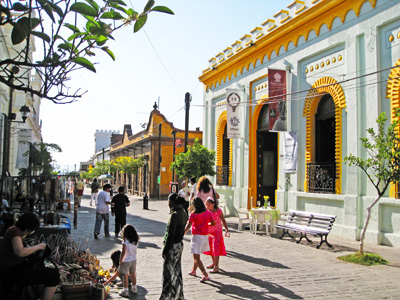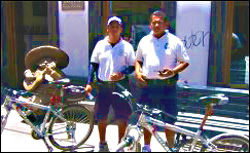|
How safe is Tlaquepaque? |
| |
 Travel inevitably entails risks, but so does staying at home: No human environment is 100% safe! Travel inevitably entails risks, but so does staying at home: No human environment is 100% safe!
Many foreign news services portray Mexico as being rife with crime and drug-related violence. Moreover, the United States Department of State has issued a Travel Warning for Mexico.
What should the prospective visitor to Tlaquepaque make of the situation?
First, one should note that the State Department's warning emphasizes that crime in Mexico is not uniformly distributed throughout Mexico. Rather, it occurs “mostly in northern Mexico, including Ciudad Juarez, Tijuana, Chihuahua City, Nogales, Matamoros, Reynosa and Monterrey.” (Of those cities, Monterrey is the closest to Tlaquepaque, being 400 miles/640 km away.)
Otherwise the State Department report warns against situations that could be dangerous in any country—“unfamiliar areas,” driving at night on unknown roads, and “demonstrations and large public gatherings.” It goes on to encourage visitors to Mexico to “stay in the well-known tourist areas.” (While not nearly as popular as, say, Cancún, Tlaquepaque, with its many visitors and bicycle-mounted Tourist Police, certainly qualifies as a “well-known tourist area.”)
A few figures may put crime in Mexico into perspective. Comparing Mexico to the United States, one website reports the following data:
|
| |
Mexico |
United States |
| Assaults per 1000 people |
2.4 |
7.6 |
| Car thefts per 1000 |
1.5 |
3.8 |
| Firearm homicide rate per 100,000 |
3.7 |
3.6 |
| Rapes per 1000 |
0.12 |
0.30 |
|
In reading these figures, it’s important to keep in mind that crime statistics are notoriously difficult to ascertain with accuracy, and comparisons between one country and another are always suspect.
Nevertheless, the general picture that emerges is that Mexico is less violent than the United States, even when Mexico’s border states are included in the calculation. (In April 15, 2009, the Los Angeles Times reported a study “claiming that tourist zones in Mexico are up to 26 times safer than many tourist zones in the United States.”) Residents of Canada and other nations, who may think of the U.S. itself as a very violent place, can go to the original website to find figures for their own countries. (You might be interested in visiting this blog to see what one Mexican considers to be the ten most dangerous things in his country.)
Like many foreigners, most Mexicans are aghast at the violence that plagues northern Mexico today. But those who live in other parts of Mexico (including Tlaquepaque) realize that the news media’s characterization of drug-related violence along the border does not reflect the realities of their own day to day lives—in the same way that people in many other countries understand that the violence they may see on their local evening television news often does not reflect the reality of their lives.
Turning specifically to Tlaquepaque, many visitors are amazed at the general feeling of safety they perceive here. Families with children stroll Jardín Hidalgo until late at night, and both women and children don’t hesitate to walk alone through the Centro Histórico.
 Tourist Police are constantly riding their bicycles in pairs around the central area, as much to answer questions and assist visitors as to maintain public safety. (Besides the Tourist Police, there are municipal, metropolitan, and federal present in Tlaquepaque. Also, on Indepedencia there are emergency telephones and security video cameras.) Members of the government know that tourism is an important component of Tlaquepaque’s economy, and therefore they go to great lengths to insure visitors’ safety. Tourist Police are constantly riding their bicycles in pairs around the central area, as much to answer questions and assist visitors as to maintain public safety. (Besides the Tourist Police, there are municipal, metropolitan, and federal present in Tlaquepaque. Also, on Indepedencia there are emergency telephones and security video cameras.) Members of the government know that tourism is an important component of Tlaquepaque’s economy, and therefore they go to great lengths to insure visitors’ safety.
Tlaquepaque does have its hazards: Pedestrians should look carefully both ways before crossing even one-way streets; and the uneven sidewalks can easily cause the unobservant to trip and fall.
As noted previously, no place is 100% safe; and the rules of prudent behavior apply as much in here as anywhere. If one uses good judgment, however, Tlaquepaque is a safe place to visit. |
|
|
|



